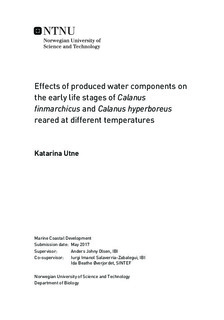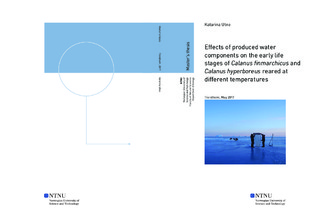| dc.description.abstract | Receding sea ice, as a result global warming, increases the marine access to the petroleum resources in the Arctic. Due to the increasing global energy demand, more oil and gas activity is likely to occur. Petroleum activities generate and release produced water into the marine environment. The polycyclic aromatic hydrocarbons (PAHs) are believed to be some of the most toxic compounds in produced water and sub-lethal effects are expected for exposed organisms. The Calanus finmarchicus (Gunnerus) and the C. hyperboreus (Krøyer) are the copepods dominating the Arctic pelagic ecosystems and the early life stages represent a critical phase among the life stages in these copepods. The present study investigates how hatching, development, growth, and oxygen consumption of eggs and the three first naupliar stages of C. finmarchicus and C. hyperboreus vary with temperature and reveal the impacts that the produced water-related PAHs have on these relationships. Eggs of C. finmarchicus and C. hyperboreus were exposed to three different concentrations of the water soluble fraction of 11 selected PAHs and raised under three different temperature in a series of laboratory studies. Time of development was monitored and measurements of oxygen consumption, dry weight, and biometric analysis were conducted for the first four life stages. Hatching time and hatching success were also determined for eggs of both species. Faster hatching and development time were found for eggs and nauplii, respectively, with rising temperature. Oxygen consumption increased with rising temperature and also with increased developmental stage. Additionally, the median length of the N3 nauplii of C. hyperboreus seemed to be reduced at 10°C. The results for the PAH exposure did not reveal a clear effect. However, hatching success was high for both species, though eggs of C. finmarchicus seemed to be more affected by PAH exposure. The dry weight of C. hyperboreus N3 nauplii were significantly lower than unexposed nauplii when exposed to the 100% concentration of the water soluble fraction. Additionally, oxygen consumption of the N2 nauplii of C. finmarchicus and the N3 nauplii of C. hyperboreus seemed to be more sensitive to temperatures when exposed to PAHs, which could potentially reduce the future recruitment of these copepods. As a consequence, less energy will be probably available for higher trophic levels that rely on the Calanus species. | |

